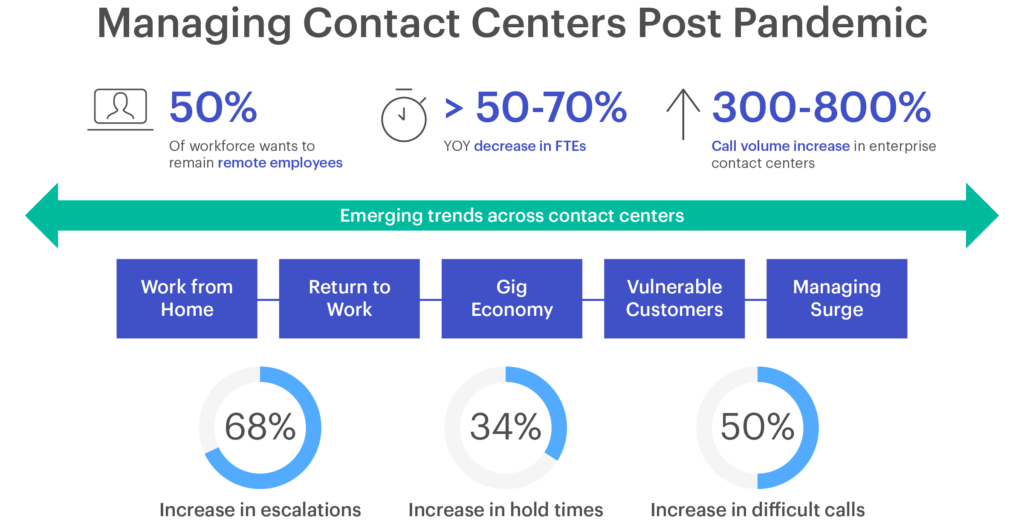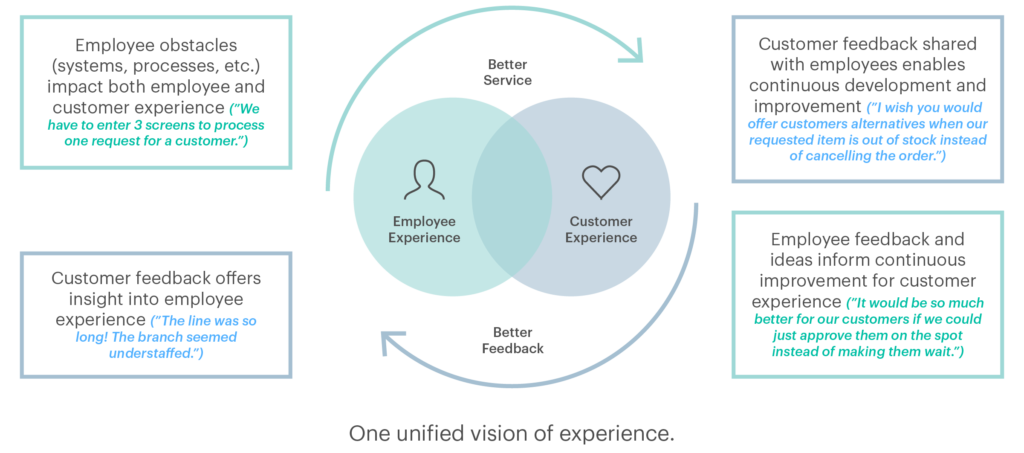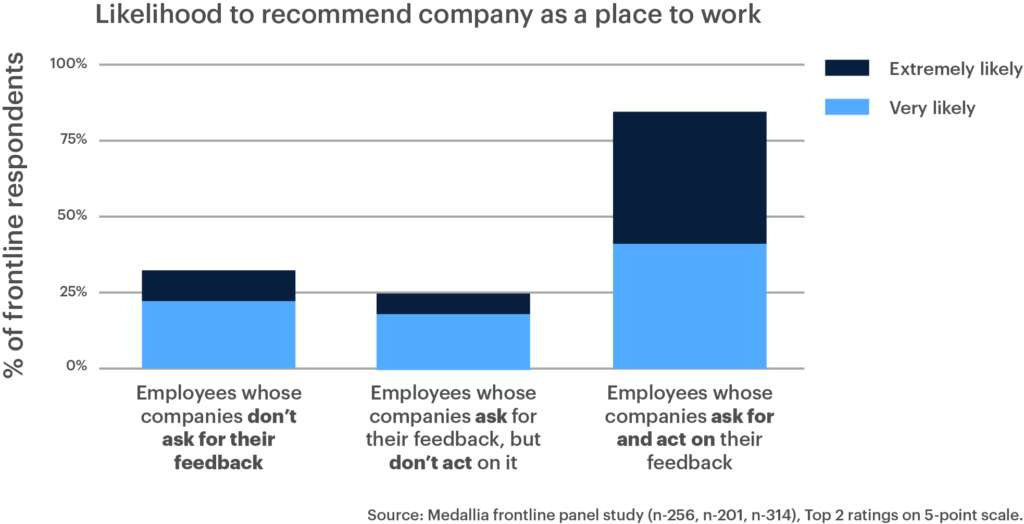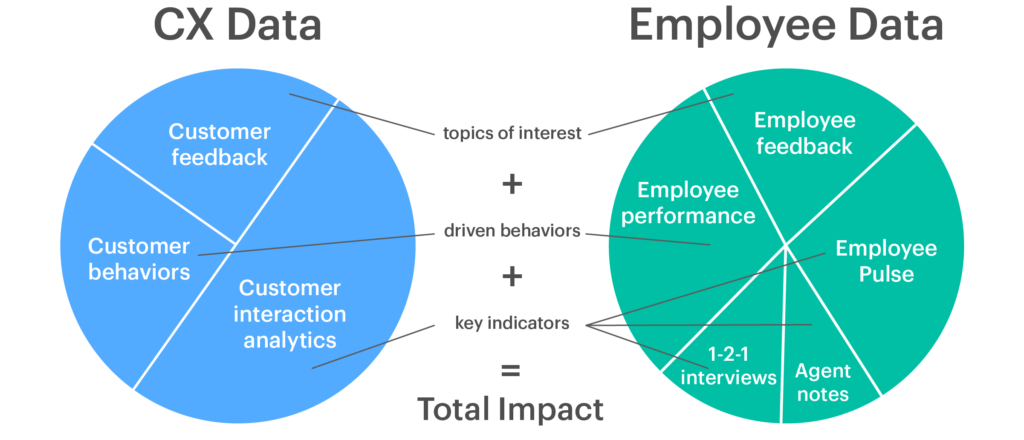As a response to staffing shortages and increasing customer demands, a new model has emerged: the hybrid contact center workforce. Here’s how (and why) it works.
In 2022, businesses will continue to reshape and retool their contact centers, where their two most valued constituencies, employees and customers, intersect. They will balance a new employee dynamic — operating with lean staff and fewer on-site agents — with customer demands, as call volume, hold times, escalations, and difficult calls surge.

A Trending Solution for Contact Centers
2021 saw several new trends within the contact center landscape. We learned that breaking down silos and taking a holistic approach is one of the most powerful ways to further transformation in 2022 and beyond. One model that is gaining popularity is connecting customer experience and employee experience to deliver an effective hybrid contact center workforce. At the heart of this model are people and data.
The New Contact Center Agent
The traditional contact center model was siloed: its workers didn’t always have an opportunity to connect to the outside world. The rise of digital channels helped break down these silos, with interactions like live chat leading to the evolution of the multi-skilled contact center agent, who might manage the phones one day and run simultaneous live chats the next day.
With many customers opting for self-service options first, contact center agents are being called upon to deal with more complex, escalating topics. To reduce attrition caused by this effect, some innovative leaders are adopting an agile model. In an agile model, training is a key priority and a flexible mix of full- and part-time staffing is utilized. This ensures the right people work at the right time, especially during peak call times, which helps boost agent engagement and productivity.
The Self-Sufficient Customer
After going through a self-service funnel during much of the pandemic, customers are now feeling more empowered. They often exhaust self-service and digital channels first before escalating their issue to a contact center. And these higher-level customer service interactions are invaluable to businesses, as they yield useful data about what the customer wants that isn’t yet provided, which aids in evolving their products and services.
The Rise of Data (& Digital)
Traditionally, contact centers were challenged by a lack of data-sharing. This was a missed opportunity, as data from the contact center represents a treasure trove of information to learn and improve upon.
The rise of digital has helped break down silos between the management of the contact center and digital channels. It’s also helped eliminate barriers to organizational data sharing, as the contact center supports customer outreach, issue resolution, and case closure, while digital channels help customers self-serve, transact, and be on their way.
Today’s leading organizations are aggregating data (creating “data lakes”) and sharing it across internal channels. And even if management is still siloed, these teams have been able to gain insights from the data and take efficient and effective action.
Connecting People & Data for a Hybrid Contact Center Workforce
In 2022, how will a company navigate a transformed contact center landscape? How will they adapt to new challenges and demands from both their employees and customers? The organizations that prosper will connect the experiences of customers and employees to understand the cross impact and subsequently drive improvement, identify best practices, and spur business growth.
Collecting customer and employee feedback, giving employees a platform to share ideas, forecasting customer needs, capturing compelling data from both, and using the right dashboards to connect the data will give businesses the following advantage: The strategic creation of a holistic picture that gets the right data to the right people at the right time to drive meaningful change.

How to Build a Hybrid Contact Center Workforce
To embark upon, or mature, this holistic experience approach that unites people and data to drive innovation, efficiency, and growth, there are four tenants to follow:
1. Understand & Connect. Then Address.
Frontline agents are a treasure trove of information. Unleash the power of their deep and rich customer engagements to understand vulnerabilities and identify valuable workarounds or permanent fixes.
To start, use agent notes more often to further identify why customers escalate a complaint, give low satisfaction scores, or leave. Create more opportunities for employee voices to be heard — consider adding pulse surveys to capture real-time feedback or to ask a probing question. Then, identify key topics of interest across two sets of feedback (from employees and customers) and incorporate this intelligence within your analytics.
2. Uncover Key Irritants
A 2021 Medallia Institute & Josh Bersin research study found that companies that are employee experience leaders were 12x more likely to indicate revenue growth of more than 20% over the last year. That’s why it’s important to understand what the most impactful irritants are for employees (and customers), and fix those first.
Consider using surveys, agent notes, and one-on-ones with frontline managers to identify what broken processes or poor technologies agents are dealing with day after day that are never fixed. They tire of making excuses, feel bad they can’t provide a better customer experience, and know it will impact their service score. This will help to build a case for the financial impact of uncovering and addressing employee and customer irritants.
3. Discover What Employees Really Value
Salary, benefits, and workplace environment all matter, but dig deeper, as it’s critical to understand what employees deeply care about and value. It may be training and education, corporate social responsibility, diversity and inclusion, or how proud they are to work for the company.
In terms of workplace pride, a Medallia Institute research study found that companies that ask for and act on frontline employees’ feedback garner the highest employee Net Promoter® scores.

4. Use the Data to Unite Customer Experience and Employee Experience
Many organizations have access to two data sources: one for customers; the other for employees. It’s critical to de-silo the data and get multiple business units to share and use the data for the common good. Then, build dashboards that bring employee data and customer data next to each other to uncover and identify the correlating impact between the two:
- Topics of interest (customer feedback and employee feedback)
- Driven behaviors (customer behaviors and employee performance)
- Key indicators (customer interaction analytics and employee pulse, agent notes, and 1-2-1 meetings)

Customer Experience & Employee Experience in 2022
Connecting customer experience & employee experience to deliver an effective hybrid contact center workforce will provide the holistic approach a company needs to create targeted actions to combat workforce challenges, while delivering improved value to customers. If both experience data sets are leveraged together, the advantages are far-reaching and can generate a significant impact on agent engagement, frontline team effectiveness, customer loyalty, operational efficiencies, product and service innovation, and future revenue in 2022 and beyond.
Looking for strategies to address today’s top contact center trends? Download Medallia’s ebook, Transforming the Modern Contact Center: The Definitive Change Management Guide











